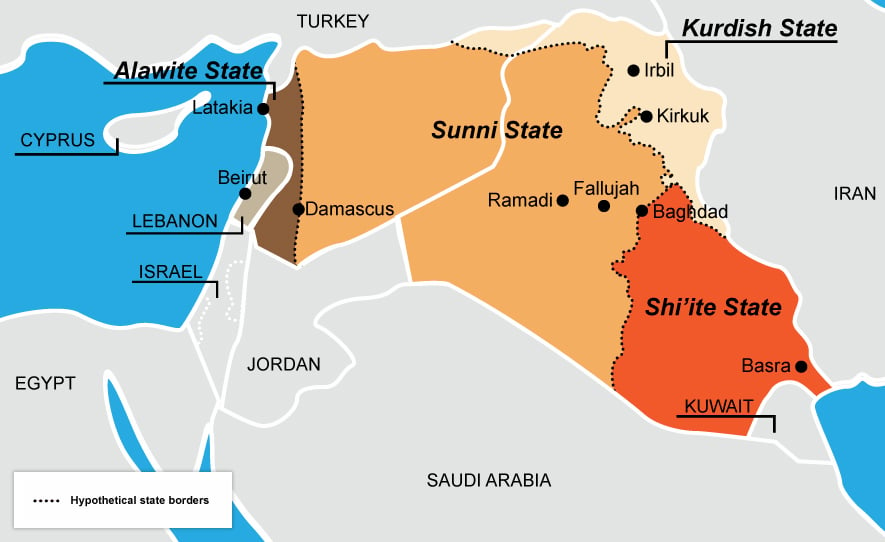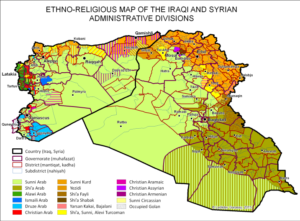Date: Sat, 25 Jun 2016 22:06:48 +0200
Sunni Areas Post-ISIS: Occupation by Sunni Powers?

(Radio Free Europe/Radio Liberty)
Iraq and Syria are currently ruled by five governments: Abadi’s government in Baghdad, Assad’s in Damascus, governments of Iraqi Kurdistan and Rojava, and the Islamic State (ISIS). Retaining the rule of the four governments over their ethnic territories is desirable while the post-ISIS Sunni areas of Iraq and Syria should be placed under foreign occupation for a transitional period. This task should be outsourced to the local Sunni Muslim powers.
Arab Counterrevolution of 2013 in Iraq and Syria
Starting during the U.S. military withdrawal from Iraq, Maliki’s regime began harassing Sunni Arabs: it got rid of Vice-President Hashemi in December 2011 and of the Minister of Finance Issawi in March 2012. The violent assault on his house triggered the disobedience campaign of the Sunni Arabs that spread from Fallujah to the whole northern Iraq. After a bloody suppression of the protests by Maliki’s regime, an unprecedented frustration of the Sunni Arab population in Iraq developed.
A similar frustration developed among the Sunni Arab population of Syria. The Free Syrian Army and its allies mostly included secular nationalist and Muslim Brotherhood affiliated forces whose main external supporters were Turkey and Qatar. Due to lack of political vision in the US and the EU, a political vacuum emerged and foreign forces opposed to the Arab Spring destabilized both countries.
Protests on the Taksim Square of Istanbul and many other Turkish cities in May-August 2013 as well as the corruption scandal of December 2013 orchestrated by the allies of Fethullah Gulen, Erdogan’s key Islamist competitor, seriously shook the regional position of Turkey. On the other hand, Saudi Arabia succeeded in removing Qatar’s Emir Hamad bin Khalifa in June 2013, which completely changed Qatar’s geopolitical orientation.
Finally, US government succumbed to the pressure of Putin’s Russia in September 2013 and abandoned the Syrian opposition in exchange for the uncertain prospect of destroying the Syrian chemical weapons caches. As a result of those events, Saudi Arabia dominated the Syrian opposition. Most of the Sunni tribes, in despair, joined extremists from ISIS and al-Qaeda’s affiliate al-Nusra Front.
Hopeless Situation Among the Sunni Arabs
ISIS and al-Qaeda succeeded among the Sunni Arabs of Iraq and Syria like the Taliban succeeded among Pashtuns in Afghanistan in 1994-96 or the Caucasus Emirate among the Chechen insurgents in 2007. Other opposition forces such as secular nationalists or the Muslim Brotherhood were marginalized. In a situation when the inhabitants have a choice between total despair and extremists promising at least a drop of hope, they often choose the latter. As the current reemergence of Taliban in many areas of Afghanistan shows, these extremists do not lose their popularity and could be even elected in future free elections.
Nowadays, any training of Syrian or Iraqi opposition forces, until recently being emphasized by the Western leaders, has become an illusion. The U.S. spent years training the Iraqi army following the 2003 invasion and its fate in the summer 2014 is generally known. The retaking of northern Iraq by the Iraqi Shi’a-dominated army and the conquering of Syria by the Assad regime means more or less returning to the status quo, where the conditions allowed for the emergence of ISIS in the spring of 2014.
Foreign Occupation, Protection and Exit-strategy
Today, one of few realistic options is the Algerian scenario from the 90s when the army pacified a society riddled with radical Islamists. As neither the Syrian nor the Iraqi armies or governments have the legitimacy or ability to undertake that task because both are Shi’a, and because the training of any Syrian opposition fighters or Iraqi tribal militia has yield little to no results, the remaining option is a foreign military occupation of Iraq’s and Syria’s Sunni areas. A historical precedent for this arrangement is the foreign military occupation of Germany and Austria by the 4 winning powers of WWII: The U.S., The Soviet Union, Britain and France.
The political solution in Syria and Iraq after defeat of ISIS should be based on the following principle: what works should be preserved while what does not work should be replaced. Assad’s government can function in Alawite areas of Syria, as can Abadi’s government in Shi’a areas of Iraq. However, they are under a strong Iranian influence and extending this influence to Sunni Arab populations of Iraq and Syria would disrupt the balance of power in the Middle East. Therefore, the Assad and Abadi governments should be limited to the Shi’a (and Alawite) areas.
There cannot be a solution for the Syrian conflict without taking into account the condition imposed by Turkish President Erdogan that disbanding ISIS must be associated with overthrowing Assad’s regime. Considering Russia’s position in Syria, Assad’s Alawite sectarian regime must be offered an exit-strategy: to retreat to traditionally Alawite areas of the Mediterranean coast (Latakia and Tartous provinces) where its survival would be ensured among members of its own ethno-religious group.
In the Sunni Arab areas of Iraq and Syria, there is no uniting force that could rule the territory and its people after the defeat of ISIS. Therefore, they should be ruled by new governments of national unity formed under a foreign occupation. The political solution would include two arrangements: occupation zones under direct military rule andprotection zones ruled by local governments as a protectorate of foreign powers. As mentioned above, occupation zones would include Sunni Arab areas of Iraq and Syria while protection zones would provide some degree of independence to the Assad and Abadi governments and to the Kurdish coalition government in Iraq and Syria.
Which Powers can be Involved in the Process
Great power competition between Russia, the United States and China has pushed the Middle East to the brink of collapse. Russia’s ties with Iran and the Assad regime are very unpopular among the Sunni. The U.S. have never been so unpopular among the Arab population since G.W. Bush’s administration. Chinese ruthless hunt for natural resources has maintained and stimulated bad governance in many countries. Therefore, having the U.S., Russia or China as occupying powers in Syria and Iraq should be completely ruled out (this does not apply to the protection zones).
Assignment of the occupation of the Sunni areas in Iraq and Syria to local Sunni powers is a must.
The United States claims that the current American bombing of Syria and Iraq is exercised by a truly international coalition including representatives of the Arab states. In reality, except from the U.S. and its NATO allies, only three Arab regimes–Saudi Arabia, the United Arab Emirates and Jordan–take part in the bombing campaign. Considered corrupt and having suppressed any dissent in their territories during the Arab Spring, these regimes cannot be considered representatives of the whole Arab world.
Saudi Arabia bears the brunt of the responsibility for the spread of Wahhabism to the rest of the Arab and Muslim world. It is an ideological parent of the extremist movements like al-Qaeda and ISIS. It is also responsible for the recent military intervention in Yemen, for harassing its Shi’a minority in the eastern parts of the country, including the execution of Saudi Shi‘a cleric Nimr al-Nimr and the bloody suppression of the Shi’a Arab Spring uprising in Bahrain.
It is responsible for the spread of Islamist extremism to Afghanistan and Pakistan, to Bosnia and Kosovo in the Balkans, Chechnya, Dagestan and Kabardia in the North Caucasus, Uzbekistan and Tajikistan in Central Asia, Tatarstan and Bashkortostan in Russia, Indonesia and the Philippines in Southeast Asia, to Egypt, Tunisia, Algeria and Libya in the Arab World, to France, Belgium, Britain and Germany in Europe. Therefore, Saudi Arabia may not take part in the occupation of Syria and Iraq in any case.
Israel is considered an enemy by most Arabs. Regardless who started the Arab-Israeli conflict, from the perspective of the Arabs, Israel is to blame for it. It is blamed for the successive wars (1948, 1956, 1967, 1973), for the Nakba (expelling of the Arabs from the Jewish parts of Palestine in 1948), for the military occupation of Lebanon (1982), for wars in southern Lebanon (1978 and 2006) and Gaza (2008 and 2014) as well as for the occupation of the Palestinian West Bank and Gaza and the Syrian Golan Heights.
Israeli occupation of the third holiest place of the Muslims, Jerusalem’s Old Town, is the reason why almost no Muslim country from Indonesia to Senegal would be willing to find a compromise solution for the conflict in Syria and Iraq that would involve the active participation of Israel.
There are only three powers in the Middle East that can lead the post-ISIS political development in Iraq and Syria: Iran, Turkey and Egypt. As mentioned above, Iran may not be included in the occupation of the Sunni Arab territories to avoid sectarian tensions. However, it should be deeply involved in the protection zones encompassing the Shi’a government in Iraq and the Alawite government in Syria.
On the other hand, Turkey and Egypt are the only Sunni countries capable to exercise the occupation tasks in the Sunni Arab areas of Iraq and Syria. Therefore, these countries should take the lead in developing viable occupation regimes for the region.
